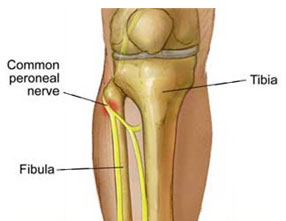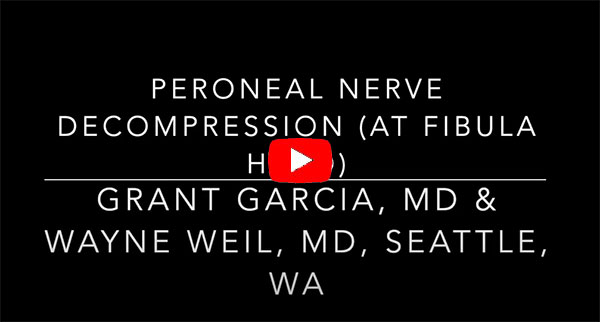Peroneal Nerve Entrapment Release
Dr. Garcia’s technique for peroneal nerve decompression

Background:
The peroneal nerve gives sensation to the top of the foot and controls the motion of the top ankle and toes. The nerve travels around the fibula through a fibrous passage called the fibula tunnel. Due to scarring or narrowing of the tunnel the common peroneal nerve can get impingement leading to nerve compression.
Symptoms:
Patients may feel numbness at the outside of their leg or numbness at the top of their foot/toes. Some patients also describe shooting pain in a similar distribution. In more severe cases, patients can develop something called a “foot drop”. This is when the patients are unable to lift their ankle due to weakness and the foot strikes the ground prematurely. This can happen acutely or be a chronic issue and can make it difficult to walk.
Diagnosis:
As with many conditions, diagnosis starts with a good physical exam which includes testing the sensory and strength parts of the leg powered by the common peroneal nerve. A positive exam is called a “Tinel’s” sign which involves reproducing the shooting pain by tapping on the nerve impingement. Even if these exam findings are negative, another test that can be done is an “EMG” which can show if the nerve is working well or if there is a partial blockage.
Treatment:
Initial treatment starts with rest, splinting and anti-inflammatories. This is reserved in many cases for patient with just sensory findings. If the patients present with leg weakness or have failed other non-operative treatment, surgical decompression is considered. An incision is made on the outside of the leg at the fibular head and the nerve is identified and release of all scarring and at the fibular tunnel. A standard dressing is applied and physical therapy is given. Recovery time is usually 3 months. Dr. Garcia is one of few surgeons who perform this surgery in Washington state, given his background in complex knee surgeries.
Outcomes:
If the true diagnosis is peroneal impingement, success rates can be as high as 90%. Many patients feel significant relief in less than 6 weeks. If patient have more severe motor damage or longer symptoms preoperatively it may take up to a year or more for return.



















